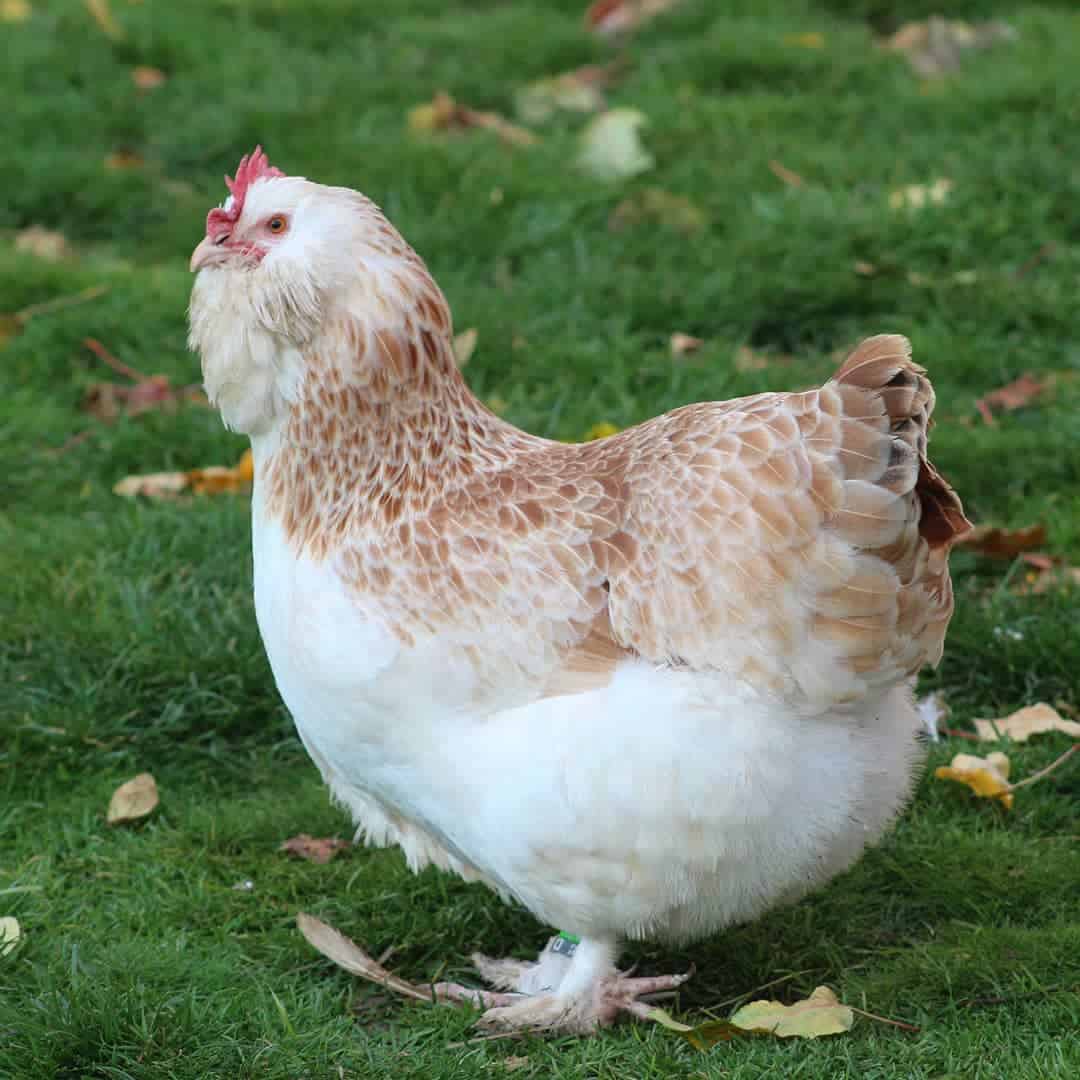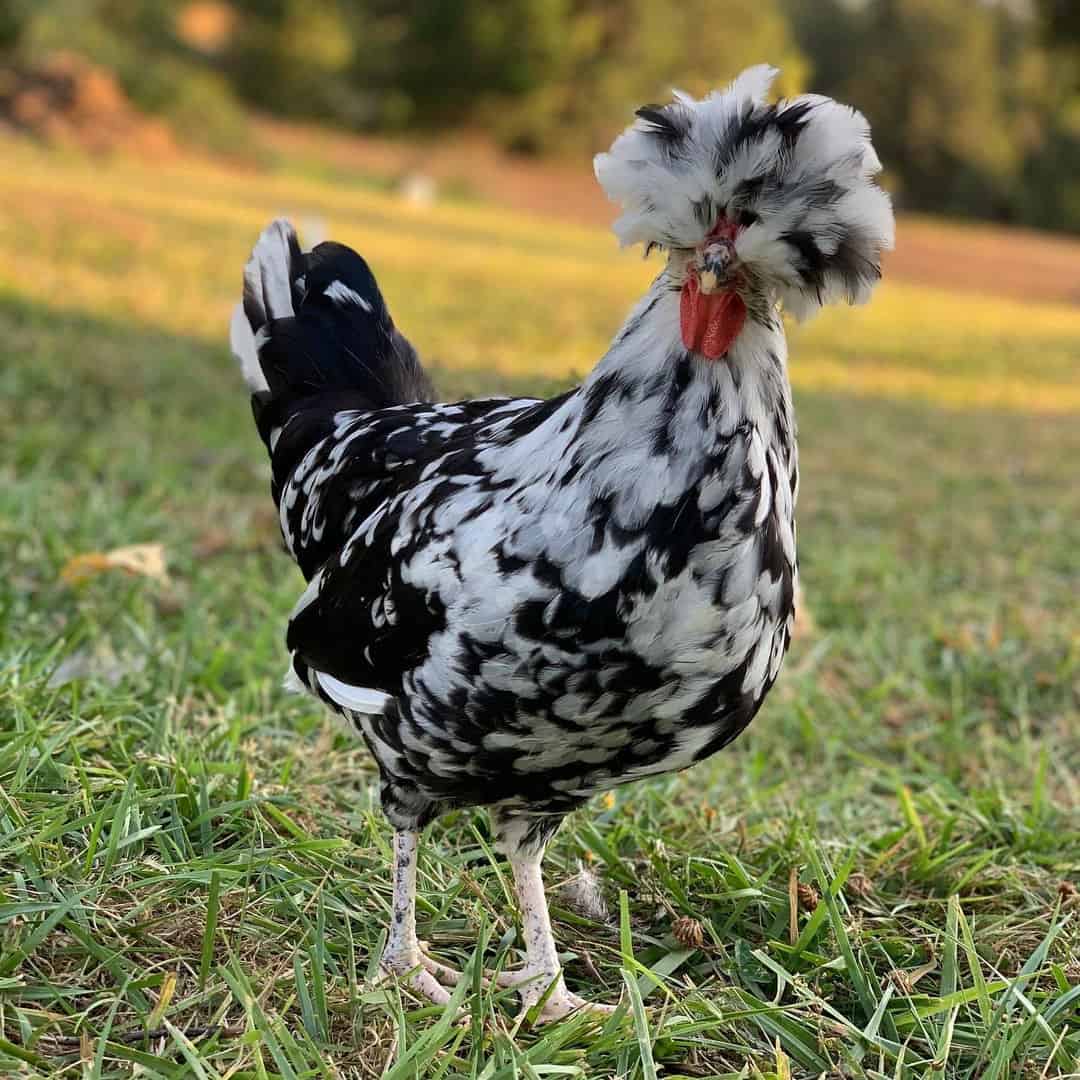Silkies are arguably the most popular chicken breeds as pets in many households around the world. Except for its fine feathers, there are many reasons why people love these birds. They are unique in nature and some of their physical characteristics are just cannot be found in other chicken breeds.
Silkies have black bones and muscles and dark reddish-black wattles. You think only Ayam Cemani has black meat and bones and you are wrong. Despite having, white feathers (for white Silkies), hidden deep inside is black skin, meat, and bones.
Another unique characteristic of Silkies is that its roosters hardly crow. Many people also claim that they never heard their Silkie rooster crow but this does not mean Silkie roosters don’t totally crow. They did, it’s just that they seldom do it.
Silkies have five toes. Yes, you heard it right. Silkie is just one of five chicken breeds that have 5 toes but some Silkie Bantams are on another level. Some unbearded Silkie Bantams have 6 toes. Technically, these silkie chickens are not adhering to the Standard of Perfection and therefore cannot be entered into competitions.) While not “normal,” the extra toe certainly is cute!
5-toed chicken breeds – here they are
Non-bearded Silkie Bantam
The Silkie Bantam is primarily an ornamental breed but its meat can also be consumed. This means that they are not reared for their meat production, and although they do lay eggs, they are certainly not considered prolific in heavy egg layers.
More than one characteristic of this chicken breed distinguishes it from others. These chickens have plumage, character, and features that are unlike any other chicken breed.
Would you want to learn more about this adorable and friendly Silkies? Aside from having thick, scruffy plumage that gives them the appearance of being very hairy, they are a chicken breed with 5 toes.

Despite their somewhat funny appearance, they have an enjoyable but kind attitude that appeals to both kids and grownups. It is believed that they are Asian birds that found their journey to the US sometime between the year 12th to 13th centuries.
What they are is incredibly unique. They have five toes (others have six), rather than the usual four, and they have a silky coat that comes from incredibly soft and fluffy feathers. They have black skin and bones, and as true bantam chickens, they weigh just 2 pounds.
While it’s true that they will lay approximately 100 eggs a year, it is worth noting that those eggs will be very small, so if you are looking for a breed to fill your breakfast plate every morning, you will need to look elsewhere.
Faverolles
The Faverolle is talkative, noisy, and something of a comedian. Owners tend to really appreciate their Faverolles because they can be quite pet-like in their mannerisms and attitude. They are named for the small village in France where they originate.
The coop comedy entertainers, the Faverolles, are zealous in their pursuits, curious to the verge of nosiness, and very chatty. They usually rush towards you whenever they spot you approaching in the hope of receiving snacks; however, even without snacks, they seem sincere in their happiness to meet you.
This chicken breed is almost ideal for the city backyard coop or homesteading, and they are rapidly gaining popularity. This chicken breed with 5 toes originated in France in the early 19th century. The name Faverolles derives from the tiny hamlet where it was discovered.
They became popular because they took equally well to life in a cage as they did to free-ranging. Hailing from France, they made their way to the UK and then to the US. As well as five toes, the Faverolle has a beard that gives them a fluffy face.
They weigh approximately 7 pounds and can be very cuddly birds. They will lay about 200 eggs a year but some owners have said that their Faverolles have been especially broody, which can bring laying to a grinding halt.
Sultan Chicken
Sultan chickens are a very ancient Turkish ornamental chicken breed. In its native environment, Turkish people are referring to them as the Serai Taook or Serai Tavuk. In Turkey, Sultan chickens are very prominent.
They are stunning, and the Turkish royalty has a fascination with keeping white fowls in his gardens, where they were eventually named the Sultans Fowl. In 1854, Sultan chickens made their first appearance in England and arrived in the US for the first time in 1867.

Nowadays, this chicken breed with 5 toes is a scarce chicken breed that is also utilized for show purposes. Sultan chickens are tiny, elegant, and completely feathered birds. They have a unique look, with magnificent feathers.
Their feathers are very ornamental from head to toe with large, plump crests, lengthy tails, beards, and a rich leg-to-foot plumage. They feature a V-shaped, small, crimson comb.
Their combs are nearly entirely concealed by feathering. The neck is densely plumed, giving the impression of a truncated head. They have smaller wattles and earlobes that are brilliant crimson in hue.
The same positive traits of the Sultan, including friendliness and sweet nature, also mean that the breed is not hardy. They cannot be thrown into the coop and left to fend for themselves. In fact, they are likely to be picked on if you have any overbearing breeds, and they are susceptible to predation.
The breed is reared for its unique looks and character. However, it is not a bird for the table or a prolific layer, so you should think carefully before taking on the Sultan chicken.
Houdan
The Faverolle was actually introduced because the popular French breed at the time did not take well to being kept in a cage. That breed was the Houdan, and this old French breed is another that has five toes on each foot.
It is considered a very heavy bird, usually weighing around 8 pounds or more, and is now considered a rare breed that can be very difficult to get hold of, depending on where in the world you are located.
Like the Faverolle, the Houdan also has a beard and is considered a sweet breed that is easy to handle and makes a friendly addition to the coop.

Houdan chickens are an ancient chicken breed renowned for their big white eggs and high-grade meat. In French, they are also known as the Poule de Houdan and were formerly known as the Normandy chicken. The country of France is the origin of the Houdan chickens and was already widespread prior to the year 1700. Numerous modest farms around the French town of Houdan are widely cultivating them.
When and how the French poultry fanciers create this chicken breed with 5 toes is still unknown. They are believed to be a hybrid between Crevecoeur chicken and either Dorking or Polish chicken; they also belong to the few chicken breed with five toes.
They were It was developed initially as a dual-purpose, utilitarian chicken breed. In 1850 Houdan chicken was introduced to England and North America 1865, respectively. Houdans are a big, bulky breed that excels as a dual-purpose utilitarian fowl capable of producing eggs and meat.
Houdan chickens are distinguished by their beard, crest, V-forming comb, and of course, their one-of-a-kind fifth toe. It is a rare chicken breed with five toes. The APA (American Poultry Association) recognizes two Houdan chicken breed varieties: mottled and white.
Dorking
Dorking chickens are among the oldest domestic chicken breeds and belong to the rare chicken breed with 5 toes. They are large, dual-purpose chickens, and their beginnings are a bit mysterious. It is thought that Dorkings evolved during the Roman Empire era somewhere in Italy.
Before 1870, the US is already widely disseminating them, and in 1874, they were accepted to the Standard of Perfection of APA (American Poultry Association). During the 19th century, the Dorkings were regarded as speedy growers with excellent shape.

However, nowadays, they are condemned for sluggish growth and development compared to modern rapidly developing chicken breeds. Without a doubt, contemporary growth aspirations are little favor to broiler production and development experts.
While Dorking chickens have an excellent meat shape and are effectively adapted to range settings, numerous modern chicken breeds are descended from the Dorking chicken breed.
Although found in several colors, the Dorking is most commonly found in white, colored, and silver-gray The White Dorking is actually considered endangered, however, so it is unlikely that you will find this color.
The Dorking is a large breed, weighing around 8 pounds. They have short legs and broad breasts, which means that they have meat in the right places. A happy Dorking will also lay up to 200 eggs a year, although the breed is known to sit longer than other breeds. The friendly breed enjoys free-ranging and makes a good addition to any coop.
Advantages of chicken with five toes
As with a lot of other animals, they rely on their feet and toes for a variety of tasks since they lack hands or front foot and the agility like humans have. These tasks include;
Roosting — chickens need to roost as high as they can, and a strong, firm hold of their toes is required to do this. A roosting perch should be present in their coop, and in free-range, they would prefer to sleep on the branches of the trees.
Digging — chickens like a nice dig, particularly if it results in a glorious dust bath for them. Chickens are capable of digging up a large amount of loose soil.
Holding — have you ever watched a chicken play first with its prey? Chicken’s instinct is to pin it down using their toes to keep the food in place.
Scratching — they scrape around every corner in search of snacks such as worms and insects, which they find with their toes.
Walking — chickens spend the majority of their time on their feet. They enjoy wandering around every corner of the coop or yard. Chickens are very fast when it comes to running, and they are challenging to catch when they are fleeing.
Frequently Asked Questions about Silkie Bantams and Silkies
Are Silkie bantams friendly?
Silkies are also known for their calm, friendly temperament, which makes them exceptionally great pets for homes that have children. In fact, silkies can be quite affectionate if owners take the time to handle them often.
Are Silkies and bantams the same?
Silkie chickens are a bantam breed that is believed to have originated in ancient China. Bantam chickens are smaller than normal-sized chickens. Silkie chickens also have beautiful, soft, fluffy feathers which are unlike those of other hard-feathered poultry.
How big do Silkie bantams get?
Silkies are fairly small, topping out at only eight to 14 inches tall. Males reach weights up to four pounds, while females tip the scales at only about three pounds. The American Standard of Perfection calls for fully grown roosters to weigh 36 ounces and hens to weigh 32 ounces.
What is unusual about the Silkie bantam chicken?
Silkies have an excellent temperament, they are luxuriously soft to the touch, they are one of the most unique breeds, they make ideal pets, and they are wonderful mother hens! Silkie Bantams are sweet, sweeter, sweetest! We love Silkie Bantams because of their sweet, gentle and friendly temperament.
Can you mix Silkies with other chickens?
Silkies get along nicely with other chickens and animals because of their calm and friendly temperament. Because of their small size and unique looks, many chickens may pick on them. Before you try “mixing” different breeds together, you need to know what to watch for and how to protect your Silkies.
What color eggs do Silkies lay?
Their eggs are a white/cream color with occasional tinting. How many eggs do they lay? They are considered poor layers, giving only 2-3 eggs per week but excellent sitters and are broody.
Can you eat silkie eggs?
Do Silkie Chickens Lay Eggs to Eat? Yes, a silkie chicken is considered a backyard chicken, and they lay white/cream-colored eggs that are safe to eat.
How many years do Silkies lay eggs?
Silkies will generally consistently lay their eggs for two years or so, then gradually their production will start to decline. A hen won’t simply one day stop laying eggs altogether.
Are Silkies loud?
Silkies are known to be less noisy compared to other chicken breeds. This is mainly due to their smaller size making them less capable to produce the volume larger chickens are able to. They have docile natures and tend to be less rowdy, but some silkies can be noisy at times.
Do Silkies like being cuddled?
Silkies don’t mind getting up close and personal with their human friends, in fact, they quite like being cuddled, kissed, and groomed, making them eggcellent pets for young children.
Are silkie chickens messy?
There are lots of reasons that you should raise silkie chickens, but of course, there are pros and cons. While their fluffy feathers are super soft, they can also get messy and cause other problems. Since they are so small they need low nest boxes and often pile on the floor to sleep at night.
Is Silkie chicken meat black?
Silky Chicken is the most exotic chicken we sell. Its black skin, black meat, and black bones are covered in snowy white feathers. Silkies can be roasted like a chicken or boiled into a tonic soup that Asians believe can strengthen the sick, elderly, and pregnant due to its “high iron” content.
Are Silkies good pets?
They’re fun, sweet-natured, and they make you breakfast! In short, they’re the perfect pet. Yep – you can definitely keep chickens as pets, and Silkies make GREAT pets, especially for households with children
At what age do Silkies start laying?
Make sure your chickens are old enough to lay. Silkies can start to lay at around 7 to 9 months of age, although some will not lay until they are much older. The older a silkie is when she begins to lay, the more eggs she is likely to produce.
Do you know any 5-toed or 6-toed chicken breeds? help us find them by leaving a comment below.
See Also:
-
- Grey Rooster Fighting Style and the Top Grey Gamefowl Breeders
- Phoenix Chicken Breed: History, Origin, and Characteristics
- Westphalian Chicken Breed: History, Origin, and Characteristics
- Vorwerk Chicken Breed: History, Origin, and Characteristics
- Icelandic Chicken Breed: History, Origin, and Characteristics